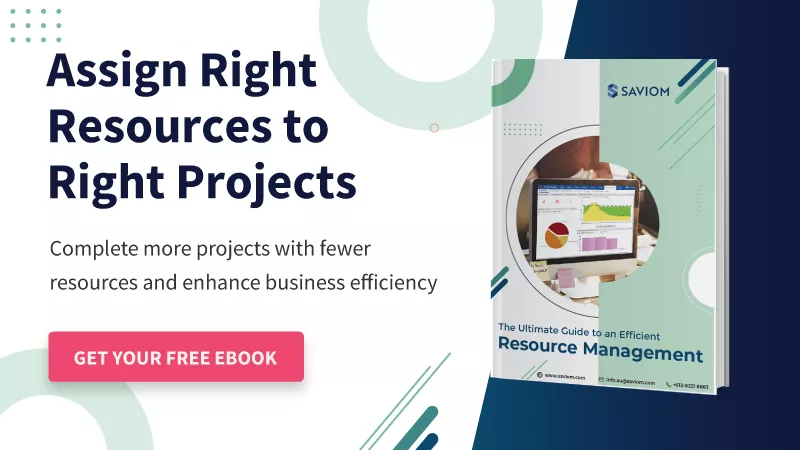According to a survey, the IT industry will experience a growth rate of 104% between 2018 to 2023.
The above statistic illustrates how the IT industry will grow exponentially in the upcoming years. In fact, the growing digitization has led to increased importance of this industry. Moreover, it plays an instrumental role in enhancing the efficiency of every other sector, be it health, education, hospitality, etc.
However, this rapid growth has brought forth challenges such as cyber-security threats, outsourcing risks, economic slowdown, resourcing bottlenecks, and more.
Amongst these, resource management challenges such as growing skills gap, sub-optimal resource utilization, lowered productivity, etc., are the major ones that can even delay or halt IT projects, resulting in client dissatisfaction and loss of business.
Therefore, to remain competitive in the long run, firms need to stay aware of these resourcing challenges and course-correct them before it’s too late.
This blog enlists the most prominent ones and proven solutions to mitigate them. Let’s begin:
What are the main characteristics of the IT industry?
Essentially, the IT industry can either be product- or service-based. The products developed range from software to different applications catering to different needs. On the other hand, the services typically include IT-enabled services (ITES), e-commerce, consulting, customer support, etc.
Also, this industry involves a multitude of human and non-human resources that help maintain the firm’s workflow. Following are some of the examples:
Human resources: Programmers, developers, data analysts, testers, UX writers, associates, etc.
Non-human resources: Tools and technologies, software, hardware, etc.
The IT projects can be for either long-term or short-term duration depending on the business requirements. The resources for the projects can work from onshore, offshore, or nearshore locations. It can also get executed in a hybrid model where the resources can be either from the in-house staff or vendor organizations.
Further, while developing an IT product or delivering a project, managers use different project management methodologies such as – Agile or Scrum. These methodologies are iterative and allow room for stage-wise changes to minimize efforts on rework.
However, managing resources in such a dynamically changing environment can be challenging and create multiple bottlenecks. The following section explains multiple resource management challenges in detail and techniques to overcome them.
Resource management challenges of the IT industry & their solutions
Resources are the most valuable asset of an IT organization because they analyze, design, and develop products and offer exemplary services to clients and customers. Hence, It’s a no-brainer that managers should manage them intelligently. However, it’s easier said than done. Managing resources in an IT industry brings forward a plethora of challenges ranging from skills gaps to burnout.
Here’s a rundown of some of the major ones and their solutions.
Growing skills gaps within the workforce
According to a survey, 64% of IT leaders see a skill gap in their companies.
With the emergence of advanced technologies such as – AI& ML, IoT– enabled gadgets, and business models, companies are experiencing a widening skills gap. That’s because the current workforce is not proficient in the new programming languages such as R, Python, etc.
As a result, specific market opportunities are lost, affecting the business. Moreover, if companies hire a mismatched skill set to execute the project, it can compromise the quality.
So, How can you combat this?
Solution: Foresee project demand and implement training methods proactively
The ideal way to tackle this challenge is to stay forewarned of pipeline projects and identify the skill requirements. Then, businesses can implement robust resource management software and enable resource managers to foresee these demands and analyze the existing skillset. Further, they can evaluate the skills gap ahead of the curve using enterprise-wide visibility.
To bridge the gap, they can conduct various training and upskilling programs and L&D initiatives to future-ready the existing workforce. This will help them hone their existing skills and acquire new ones to take on advanced projects.
Read More: How Can Retraining/Upskilling Future-Proof Your Workforce?
Last-minute firefighting to fulfill pipeline demand
When resource managers cannot foresee the pipeline projects in advance or do not receive the resource request on time, it’s challenging to identify competent resources during project initiation. This triggers the last-minute firefighting, and in addition, it can result in increased hiring costs if a niche-skilled resource is recruited at the last moment. Moreover, it may even result in the hiring process can compromise resource quality which can adversely affect the delivery.
So, what is the suitable solution?
Solutions: Ensure effective capacity planning ahead of curve
As mentioned earlier, resource managers can use an ERM software to get foresight into pipeline and approved project demand. Based on this data, they can initiate capacity planning. Using the capacity vs. demand reports, they can proactively identify the excess or shortage of resources.
If there is a shortage, managers can initiate planned hiring with enough lead time in hand. It will ascertain that the right resource is hired at the right cost. They can also retrain benched resources or employees with partially matching skillet before the project’s onset and provide them suitable training to bridge the gap.
Read More: 9 Effective Ways to Manage Capacity Planning Bottlenecks
Sub-optimal resource utilization in the IT industry
According to Gartner analyst Rober Handler, the sweet spot for productivity is between 70% and 80%.
Less than that or above will lead to sub-optimal resource utilization, negatively impacting the resource health index. Sometimes due to silos of data and lack of real-time insights into the resource availability, resource managers double-book or under-allocate IT employees. Overallocation of resources will lead to stress and burnout, which can cause unplanned attrition. On the contrary, underutilization of a resource will result in disengagement, leading to a demotivated workforce.
So, how can you prevent this?
Solution: Maximize productive workforce utilization
You can address this challenge with the help of a resource management solution. The tool offers a multidimensional view of enterprise-wide resource’s current and future allocations on a centralized platform. If a resource is allocated to non-billable or admin work for most of the capacity, managers can mobilize them to relevant strategic or billable work. This will facilitate them to maximize productive utilization and enhance profitability.
For instance- a web developer is allocated to work on non-billable or admin tasks like- data entry for 50% of their capacity. In that case, the resource manager can mobilize them to billable or strategic projects, allowing them to use their skill in revenue-generating work. Similarly, if employees are overutilized, the manager can either adjust the project timeline or procure additional resource to ensure uniform workload distribution.
Read More: What is Resource Utilization? A Complete Guide to Improve Business Efficiency
Increase in bench size
Due to a lack of visibility into current and future project and resource schedules, resource managers cannot foresee projects approaching ramp down. As a result, employees from several projects end up on the bench. For example, let’s consider a software development project. During the initial phase, the project demands multiple resources, such as developers, analysts, designers, etc., to build the software. However, when the project has reached the final stage, only limited resources are required to test the software and finalize it. At this point of time, the project manager rolls off the excess of resources, causing a ramp-down.
So, how to manage this increasing bench size?
Solutions: Manage ramp-up and ramp-down activities Intelligently
First and foremost, resource managers can oversee resources future schedules to understand when they will be rolled off from projects. Accordingly, they can allocate appropriate work in advance.
Moreover, they can use people on the bench and project vacancy reports to foresee the resources who will be relieved from projects. Resource managers can then compare the project vacancy report and allocate the tasks that will align with their skill set. If the skills are partially aligned, they can conduct training programs before the project begins.
Read More: How to Balance Ramp-Ups and Ramp-Downs in a Project?
Ineffective resource management in agile projects
As mentioned earlier, IT projects primarily implement an agile project management methodology. Since it is an iterative approach and is subject to dynamic changes, it is imperative for managers to have resource-related information in real-time. If not, it can cause delays, hamper the interdependent tasks, and disrupt the product backlog and release planning. The lack of visibility into resource attributes poses a challenge in managing them in agile projects.
How can you combat these issues?
Solutions: Use resource management software to manage resources
Using resource management software, managers can have resourcing information at their fingertips. For instance, if an ad hoc change is requested during one sprint and requires additional resources, managers can identify the right resource with 360-degree visibility.
In addition to that, the tool provides information on various resource metrics, project financials with forecast vs. actual reports, etc. Thus managers can balance people, time, and budget to deliver the project successfully. Moreover, by leveraging the resource utilization reports, managers can take corrective measures if a resource is spending more time than forecasted on non-billable activities such as scrum meetings or sprints.
Read More: How to Manage Resources in Agile Project Management?
Unplanned attrition
According to a survey, 37% of employees left their organization due to a lack career growth.
Often, project managers choose the same critical resources for their projects as they perform well and have built a good rapport. As a result, the other resources will have fewer opportunities to enhance their portfolios. Furthermore, the resources working on similar projects will start experiencing career stagnancy. Both employees with a lack of career opportunities and the ones feeling stuck will look for opportunities elsewhere.
What do you think can be done to prevent this?
Solutions: Empower employees to choose work of their interest
To prevent employee turnover, managers can give employees a choice to select projects of their interest. With the resource management tool, they can publish open positions mentioning specific requirements such as skills, qualifications, etc.
Accordingly, resources interested in the open position can apply and wait for the approval. The manager will then analyze the competencies of interested resources and allocate the right resource to the project. Since employees can work on projects that interest them, they will be more motivated and engaged, thereby reducing the attrition rate. Additionally, organizations can promote interdepartmental collaboration to encourage employees to diversify their portfolio. Lastly, they can also invest in succession planning to avoid any bottlenecks.
Employee burnout
According to a survey, 80% of workers feel they are burning out due to excessive workload.
The issue of burnout is a serious concern for employees in the IT industry.
Long working hours, limited flexibility, insufficient appreciation, no work-life balance, and the traditional bell-curve rewards system are some causes of employee stress and burnout.
For example- A software developer works long hours just to fix a bug in the software and finish the project within the deadline. The unmanageable workload, unrealistic deadlines, etc., are significant causes of burnout. Further, sometimes managers over allocate resources without having complete visibility of their available capacity and utilization, resulting in overutilization and burnout.
What is the ideal way to prevent burnout and unplanned absenteeism?
Read More: How Workforce Planning Prevents Employee Burnout Down the Line
Solutions: Implement resource optimization techniques
A simple solution to this issue is to leverage resource management software and get insights into the real-time utilization heatmap. It gives you a comprehensive view of your resources’ utilization rates in a color-coded manner. If a resource is over-utilized, you can procure additional resources and adjust project timelines. These are known as resource optimization techniques.
Also, the tool lets you compare the forecast vs. actual utilization. If a resource is spending more time than forecasted, then managers can course-correct ahead of time.
The bottom line
Attributing to the ongoing advancements and emergence of new technology trends in the industry, the IT sector is plagued by various resource-centric challenges. If not appropriately handled, these challenges will negatively impact the IT projects and profitability. Unless businesses take proactive measures to combat these roadblocks, it will adversely affect the top line and bottom-line of any company.
The Glossary
Read More: Glossary of Resource Workforce Planning, Scheduling and Management
The SAVIOM Solution
SAVIOM is the market leader in offering the most powerful and configurable solutions for managing enterprise resources efficiently and effectively. Having more than 20 years of experience, this Australian-based MNC has a global presence in over 50 countries. It is also popular with more than 100 customers and helps them achieve their business goals. SAVIOM also has products for project portfolio management, professional service automation, and workforce planning software which can be easily customized as per business requirements.












